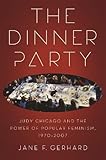The Dinner Party : Judy Chicago and the Power of Popular Feminism, 1970-2007 / Jane F. Gerhard.
Material type: TextSeries: Publication details: Athens, GA : The University of Georgia Press, (c)2013.Description: 1 online resourceContent type:
TextSeries: Publication details: Athens, GA : The University of Georgia Press, (c)2013.Description: 1 online resourceContent type: - text
- computer
- online resource
- 9780820345680
- NK4605 .D566 2013
- COPYRIGHT NOT covered - Click this link to request copyright permission: https://lib.ciu.edu/copyright-request-form
| Item type | Current library | Collection | Call number | URL | Status | Date due | Barcode | |
|---|---|---|---|---|---|---|---|---|
 Online Book (LOGIN USING YOUR MY CIU LOGIN AND PASSWORD)
Online Book (LOGIN USING YOUR MY CIU LOGIN AND PASSWORD)
|
G. Allen Fleece Library ONLINE | Non-fiction | NK4605.5.63 (Browse shelf(Opens below)) | Link to resource | Available | ocn842264866 |
Browsing G. Allen Fleece Library shelves, Shelving location: ONLINE, Collection: Non-fiction Close shelf browser (Hides shelf browser)
Includes bibliographies and index.
Judy Chicago's monumental art installation The Dinner Party was an immediate sensation when it debuted in 1979, and today it is considered the most popular work of art to emerge from the second-wave feminist movement. The author examines the piece's popularity to understand how ideas about feminism migrated from activist and intellectual circles into the American mainstream in the last three decades of the twentieth century. More than most social movements, feminism was transmitted and understood through culture-art installations, Ms. Magazine, All in the Family, and thousands of other cultural artifacts. But the phenomenon of cultural feminism came under extraordinary criticism in the late 1970s and 1980s. The author analyzes these divisions over whether cultural feminism was sufficiently activist in light of the shifting line separating liberalism from radicalism in post-1970s America.
Toward a cultural history of The Dinner Party -- Making feminist artists : the feminist art programs of Fresno and CalArts, 1970-1972 -- Making feminist art : Womanhouse and the feminist art movement, 1972-1974 -- The studio as a feminist space : practicing feminism at The Dinner Party, 1975-1979 -- Joining forces : making art and history at The Dinner Party, 1975-1979 -- Going public : The Dinner Party in San Francisco, 1979 -- The tour that very nearly wasn't : The Dinner Party's alternative showings, 1980-1983 -- Debating feminist art : The Dinner Party in published and unpublished commentary, 1979-1989 -- From controversy to canonization : The Dinner Party in the culture wars, 1990-2007 -- A prehistory of post feminism.
COPYRIGHT NOT covered - Click this link to request copyright permission:
There are no comments on this title.







